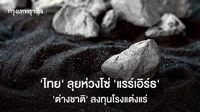Thailand is rapidly emerging as a key player in the global rare earth elements (REE) supply chain, with recent investments and policy shifts highlighting both opportunities and challenges in the race toward greener technologies. On October 19, 2025, Neo Magnequench, a subsidiary of Canada’s Neo Performance Materials, reported a staggering 261% increase in its rare earth production capacity compared to the prior year. This surge is largely fueled by the booming demand for magnets used in electric vehicles (EVs) and advanced electronics, industries at the heart of the world’s transition to clean energy.
According to Bangkok Biz News, Neo Magnequench’s factory in Nakhon Ratchasima has become the company’s most important production base in Southeast Asia. The facility processes imported rare earth minerals—primarily neodymium and praseodymium—into permanent magnets that power everything from EV motors to high-tech consumer devices. With a production capacity of several thousand tons per year, the plant is poised to supply major automotive and electronics manufacturers across Asia, including Thailand’s rapidly expanding EV sector.
This growth comes at a time when the European Union (EU) is tightening environmental regulations for global businesses. On October 19, 2025, the EU announced new rules under the Corporate Sustainability Reporting Directive (CSRD), requiring companies to disclose detailed environmental and social information starting in 2026 and extending to 2028. These requirements dovetail with the EU’s Emissions Trading Scheme (ETS) and the Carbon Border Adjustment Mechanism (CBAM), both of which aim to reduce carbon leakage by imposing costs on imports with high carbon footprints. The CBAM, in particular, will impact exporters of steel, cement, aluminum, and, crucially, components like rare earth magnets that are central to green technologies.
Kasikorn Research Center, cited by Thai News Agency, emphasizes that the EU’s decision to delay full sustainability reporting for non-EU companies until 2028 does not affect the timeline for CBAM implementation. Thai exporters, especially those in steel, cement, and aluminum, must still adapt quickly to avoid punitive carbon tariffs. The center suggests that companies begin by collecting carbon data, investing in immediate green projects like solar installation and sustainable waste management, and seeking green financing to offset costs. The so-called ‘Greenium’—financial incentives for sustainable investments—could help businesses lower their borrowing costs as they transition to cleaner operations.
Thailand’s strategic position in the rare earth supply chain is further underscored by its dual role as a processor and exporter. Although the country lacks large-scale rare earth mines, it imports raw materials for value-added refining and then exports the finished products. This approach has propelled Thailand into the ranks of mid-tier rare earth producers globally, with export values exceeding $50 million annually. The government is also developing a “Clean Tech Industry Roadmap” to promote rare earth processing, permanent magnet manufacturing, and recycling—laying the groundwork for a more integrated, high-value supply chain that supports both domestic and regional demand.
Industry insiders, speaking to Bangkok Biz News, highlight the synergy between Thailand’s magnet manufacturing capacity and its burgeoning EV industry. BYD, a leading Chinese EV brand, recently opened a $486 million assembly plant in Rayong, boosting local demand for rare earth magnets and other components. As more automakers establish operations in Thailand, the country is expected to reach its target of producing one million EVs per year within the next three to five years. This will significantly increase domestic consumption of rare earth materials and create a robust regional supply chain, reducing reliance on imports from China and other global players.
The government’s push to explore new rare earth deposits and invest in recycling technologies is also key to adding value and mitigating environmental risks. Most of Thailand’s rare earth reserves—mainly monazite and xenotime—are found alongside tin and heavy mineral mining in southern provinces like Ranong, Takua Pa, Phang Nga, and Songkhla. While current reserves are modest, estimated at just 4,500 tons of rare earth oxides (REO) according to the US Geological Survey, ongoing exploration and technological upgrades could unlock new sources and reduce the ecological impact of extraction.
However, the rare earth industry faces formidable challenges. China remains the world’s dominant producer and processor of rare earths, holding reserves of 44 million tons REO—nearly half of the global total. Recent Chinese government measures requiring export licenses for rare earth shipments have raised concerns about supply chain security, particularly for industries dependent on these critical materials. The United States, by contrast, holds just 1.9 million tons of reserves, making it heavily reliant on imports from China. Other major reserve holders include Brazil, India, Australia, Russia, and Vietnam, with Thailand ranked much lower in terms of raw material endowment.
Neo Magnequench, for its part, has opted to focus on processing and manufacturing rather than upstream mining. As a company spokesperson told Bangkok Biz News, “Neo does not emphasize owning mines as much as processing and producing magnets, which helps reduce the volatility of mining markets and the high capital costs associated with mining.” This strategy allows the company to respond more flexibly to market shifts, technological advances, and regulatory changes—especially as competition from China and other producers intensifies.
Environmental responsibility is also a growing concern. Rare earth processing often involves hazardous chemicals and generates waste that must be managed carefully to comply with both local and international regulations. Neo Magnequench has adopted solar energy and earned accolades from sustainability rating agencies like EcoVadis, using these credentials to bolster its reputation as an environmentally conscious manufacturer. Still, the company and its peers must navigate complex legal, technological, and community expectations as they scale up production.
Looking ahead, the intersection of EU policy, regional industrial growth, and global supply chain dynamics will shape the future of Thailand’s rare earth industry. The CBAM and CSRD will push companies toward greater transparency and cleaner production, rewarding those who invest early in green technologies and sustainable practices. The rapid expansion of EV manufacturing, combined with government support for clean tech and recycling, positions Thailand to play a pivotal role in the next generation of high-tech, low-carbon industries.
As the world pivots toward cleaner energy and advanced electronics, Thailand’s efforts to build a more resilient, sustainable rare earth supply chain may well determine its place in the global economic landscape for years to come.




